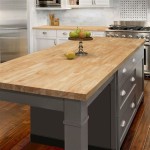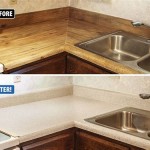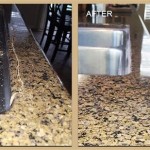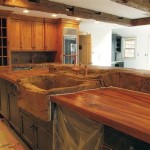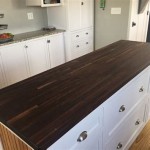How To Cover a Countertop with Contact Paper
Contact paper offers a cost-effective and relatively simple solution for updating the appearance of countertops without the expense and disruption of a full replacement. This method is particularly useful for renters looking to personalize their space without making permanent changes, or for homeowners seeking a temporary cosmetic fix. While contact paper provides a visual improvement, it is crucial to understand its limitations regarding durability and heat resistance. This article details the process of applying contact paper to countertops, emphasizing preparation, application techniques, and considerations for long-term maintenance.
Preparing the Countertop Surface
The longevity and aesthetic appeal of contact paper application hinges heavily on proper surface preparation. A thoroughly cleaned and smooth surface is essential for optimal adhesion and a professional-looking finish. Neglecting this step can result in bubbles, wrinkles, and premature peeling of the contact paper. The following steps outline the recommended surface preparation process.
First, the countertop must be thoroughly cleaned. Start by removing all items from the surface, including appliances, decorative objects, and any other obstructions. Using a degreasing cleaner, wipe down the entire countertop to remove grease, grime, and any accumulated residue. Pay particular attention to areas around the sink and cooking surfaces, where grease and food splatters are more likely to be present. Rinse the countertop with clean water to remove any remaining cleaner residue. Allow the surface to dry completely before proceeding.
Next, inspect the countertop for any imperfections. This includes chips, cracks, scratches, and uneven surfaces. Minor imperfections can be addressed with a filler compound designed for countertop materials. Apply the filler according to the manufacturer's instructions, allowing it to dry completely. Once the filler is dry, sand the affected areas smooth using fine-grit sandpaper. This will create a level surface for the contact paper to adhere to effectively.
After addressing any imperfections, thoroughly clean the countertop again to remove any sanding dust or debris. A damp cloth followed by a dry cloth will ensure a clean surface. Allow the countertop to dry completely before moving on to the next step. A perfectly clean and smooth surface is the foundation for a successful contact paper application.
Finally, consider the existing countertop material. Porous materials may benefit from a primer application. A primer will create a smoother, more uniform surface, improving the contact paper's ability to adhere evenly. Choose a primer that is compatible with both the countertop material and the adhesive of the contact paper. Apply the primer according to the manufacturer's instructions and allow it to dry completely before proceeding.
Applying the Contact Paper
The application process requires patience and precision to achieve a smooth, bubble-free finish. It is recommended to work in a well-lit area to ensure clear visibility and accurate placement. Having the necessary tools readily available will also contribute to a more efficient and satisfactory application. The following steps detail the recommended application process for contact paper on countertops.
Begin by measuring the countertop surface to determine the amount of contact paper needed. It is crucial to add extra material to account for overlaps, trimming, and potential errors. Overestimating is preferable to underestimating, as excess material can always be trimmed away. Cut the contact paper to the measured size, adding a few inches of overlap on all sides. This overlap will allow for precise adjustments during the application process.
Peel back a small portion of the contact paper backing, exposing the adhesive. Align the exposed adhesive edge with the edge of the countertop. Carefully press the adhesive onto the surface, ensuring it is smooth and even. Use a smoothing tool, such as a plastic scraper or a credit card wrapped in a soft cloth, to press out any air bubbles as you proceed. Work slowly and methodically, peeling back more of the backing and smoothing the contact paper onto the countertop surface. Avoid pulling the contact paper too tightly, as this can cause stretching and distortion.
Continue the process of peeling back the backing and smoothing the contact paper onto the countertop, working in small sections. Pay close attention to areas around sinks, edges, and corners, as these can be challenging to navigate. Use a sharp utility knife to carefully trim the contact paper around these features, leaving a clean and precise edge. Overlap sections of contact paper slightly, ensuring a seamless transition. Once the entire countertop is covered, carefully inspect the surface for any remaining air bubbles. Use a pin or needle to puncture the bubbles and smooth out the contact paper with the smoothing tool.
After the initial application, use a heat gun or hairdryer on a low setting to gently warm the contact paper. This will help the adhesive to bond more firmly to the countertop surface. Be careful not to overheat the contact paper, as this can cause it to melt or distort. Apply gentle pressure with the smoothing tool as you heat the contact paper. This will help to ensure a smooth, even finish.
Finally, trim any excess contact paper along the edges of the countertop using a sharp utility knife. Use a straight edge as a guide to ensure a clean and precise cut. Smooth the edges of the contact paper to ensure they are firmly adhered to the countertop surface. Inspect the entire countertop for any imperfections and address them as needed. A well-applied contact paper surface should be smooth, even, and free of bubbles or wrinkles.
Maintaining the Contact Paper Surface
While contact paper offers a relatively durable surface, it is important to understand its limitations and implement appropriate maintenance practices to prolong its lifespan. Contact paper is not as resilient as traditional countertop materials such as granite or quartz, and it is susceptible to damage from heat, scratches, and harsh chemicals. The following guidelines outline recommended maintenance practices for contact paper countertops.
Regular cleaning is essential for maintaining the appearance of contact paper countertops. Wipe down the surface daily with a damp cloth and a mild detergent. Avoid using abrasive cleaners or scrub brushes, as these can scratch or damage the contact paper. For stubborn stains, use a mixture of baking soda and water to gently scrub the affected area. Rinse the countertop with clean water and dry thoroughly after cleaning. Promptly address spills and stains to prevent them from setting into the contact paper surface.
Protect the contact paper from heat damage by using trivets and hot pads under hot pots, pans, and dishes. Contact paper is not heat resistant and can melt or scorch if exposed to high temperatures. Avoid placing hot appliances directly on the countertop surface. Similarly, use cutting boards when preparing food to prevent scratches and cuts to the contact paper. Knives and other sharp objects can easily damage the surface, so it is important to protect it during food preparation.
Avoid using harsh chemicals or solvents on the contact paper surface. These substances can damage the adhesive and cause the contact paper to peel or discolor. If you need to use a stronger cleaner, test it in an inconspicuous area first to ensure it does not damage the contact paper. Generally, mild detergents and water are sufficient for most cleaning tasks. Pay particular attention to areas around the sink and cooking surfaces, as these are more prone to spills and stains.
Regularly inspect the contact paper for any signs of damage, such as peeling edges, bubbles, or scratches. Address these issues promptly to prevent them from worsening. Use a small amount of adhesive to re-adhere any peeling edges. Puncture any bubbles with a pin or needle and smooth out the contact paper with a smoothing tool. Replace damaged sections of contact paper as needed to maintain a consistent and attractive appearance. With proper care and maintenance, contact paper countertops can provide a temporary and cost-effective solution for updating the look of your kitchen or bathroom.

How To Cover A Countertop With Contact Paper Craft Your Happiness

Contact Paper Counter Makeover Before After Realistic Marble Youtube

How To Cover A Countertop With Contact Paper Craft Your Happiness

Transform Your Kitchen With Contact Paper For Countertops Cabana State Of Mind

Marble Contact Paper Countertop 10 Months Later Anika S Diy Life

How To Install Peel And Stick Contact Paper Countertop Backsplash Makeover Er Friendly Youtube

How To Do A Sturdy Stunning Granite Contact Paper Countertop Makeover Craft Your Happiness

Diy 100 Contact Paper Countertops

100 Update Ugly Granite Countertop W Contact Paper Paint Or Epoxy You Ll Want To See This

Diy Countertops With Contact Paper


